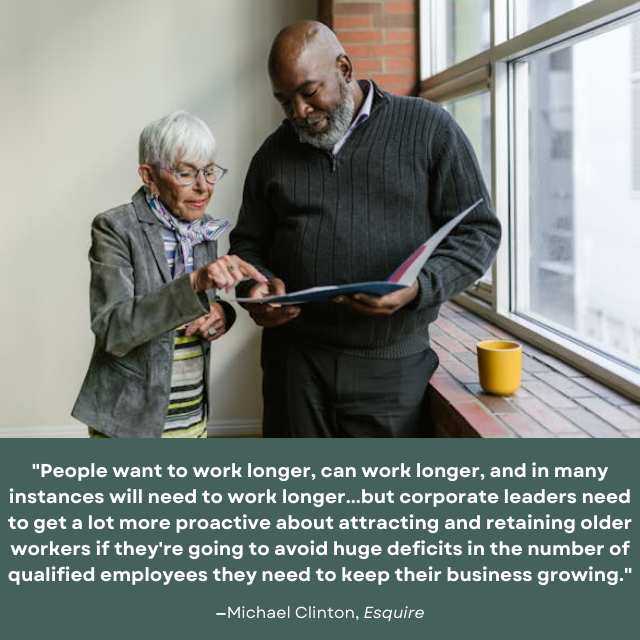Diversity and inclusion are increasingly important considerations for corporations fostering innovation and driving growth. However, one area where discrimination persists is in the perception and treatment of older workers. Despite the wealth of experience and expertise they bring to the table, older employees often face challenges in accessing training opportunities and advancing their careers within corporate settings. How can employers overcome ageism and invest in training older workers, and what are the advantages?
We are at a unique point in history, where five generations are working together. In a recent Esquire article, David Greenberg, CEO of L’Oréal USA, says, “In this new environment, where age inclusivity will be vital, we must not only recruit and develop talent at all stages of their careers with wellbeing [sic] benefits to match, but to create opportunities for people to exchange their valuable knowledge and experiences with enthusiasm. As someone who has been building a career for nearly 40 years, I personally welcome this evolution.”
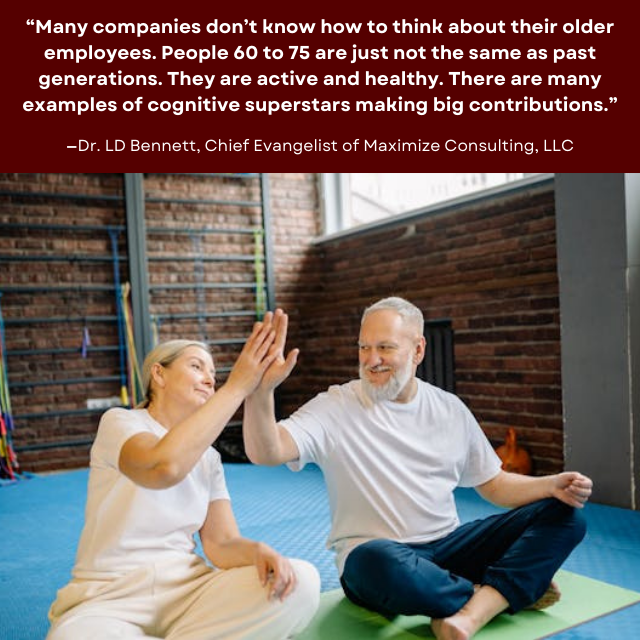
Understanding the Challenge
Ageism, the discrimination or prejudice against individuals based on their age, can manifest in various forms within the workplace. Older workers may encounter stereotypes that portray them as technologically inept, resistant to change, or lacking in adaptability compared to their younger counterparts. As a result, they may be overlooked for training opportunities, promotions, or new roles, despite their proven skills and experience. Research from the Society for Human Resource Management (SHRM) reveals:
- Nearly one-third (32 percent) of HR professionals say an applicant’s age played a role in the job application process.
- 11 percent of HR professionals say older employees are not always treated as fairly as younger workers.
- 26 percent of US workers 50 and older say they have been the target of age-related comments in the last six months.
However, research has consistently shown that age-diverse teams are more innovative, productive, and resilient. Older workers bring valuable perspectives, insights, and problem-solving abilities honed over years of experience in their respective fields. By harnessing the collective wisdom of multi-generational teams, corporations can gain a competitive edge and drive long-term success.
The SHRM report goes on to say, “More individuals are choosing to work beyond traditional retirement years, resulting in the emergence of a multi-generational workforce. Understanding and addressing age discrimination is essential to fostering inclusive work environments that value employees of all ages.”
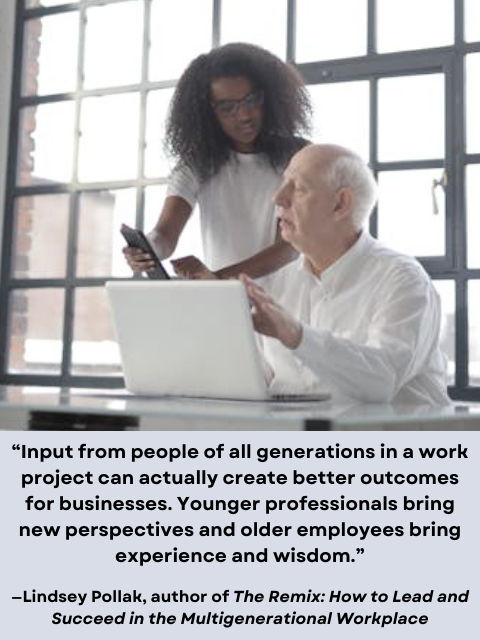
Breaking Down Barriers
According to Pew Research Center, the older workforce in the US has nearly quadrupled in size since the mid-1980s, and the US Bureau of Labor Statistics predicts that adults over 65 will account for 57 percent of the labor force growth by 2032.
To overcome ageism and create an inclusive workplace culture, companies must take proactive steps to address biases, stereotypes, and systemic barriers that hinder the advancement of older workers. This includes implementing policies and practices that promote diversity, equity, and inclusion at all levels of the organization.
One effective strategy is to provide training and professional development opportunities specifically tailored to the needs of older workers. This may involve offering technology training to enhance digital literacy, reskilling programs to adapt to evolving job roles, or leadership development initiatives to cultivate the next generation of senior executives.
Additionally, mentorship and reverse-mentoring programs can facilitate knowledge transfer and collaboration between older and younger employees, fostering mutual learning and understanding. By fostering intergenerational mentorship relationships, corporations can leverage the strengths of each generation while bridging the generation gap and promoting a culture of continuous learning and growth.
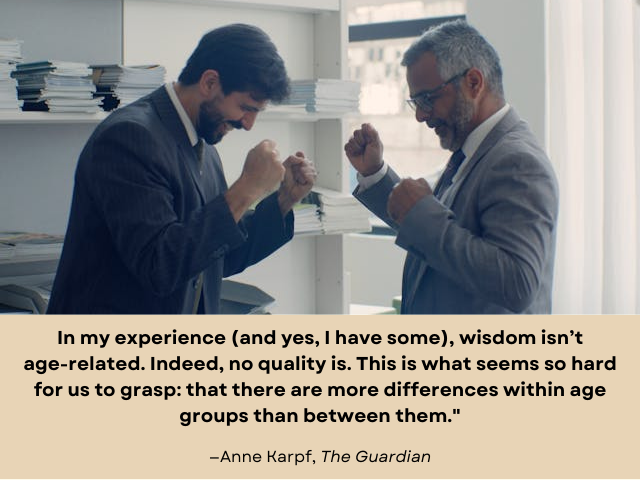
Myths about Older Workers
Older workers don’t have today’s skills.
On the contrary, seniors are willing and highly capable of learning new skills, building off their existing knowledge. According to a 2021 survey from the American Association of Retired Persons (AARP), 94 percent of older workers want to learn additional job skills through training. Organizations should offer them development programs, especially for technical skills.
Kevin Delaney, co-found of Charter, a future-of-work media and research company, says, “In reality, older workers might be better equipped for working with AI, as the ability to delegate work and review what comes back are some of the most critical skills for applying AI tools effectively. Those skills tend to be more developed in workers with longer tenures and more management experience, suggesting that organizations can’t afford to overlook older workers when implementing AI into their business.”
Older workers are in cognitive decline.
“The idea that cognitive decline is inevitable as we get older is not only ageist but ignores a growing body of evidence that some aspects of cognition actually improve as we age,“ says Dr. Mark Lachs, a geriatrician at Weill Cornell Medicine. He goes on to say that some elements of cognitive functioning – verbal memory, vocabulary, and some types of reasoning abilities, can improve well into our 70s.
As we age, our built-up knowledge (referred to as “crystallized intelligence”) tends to improve, leading to better job performance – particularly handy as today’s jobs focus more on services and information than in the past. Older workers also surpass their younger colleagues in some key performance areas. An international study reported that adults ages 65 to 80 perform more consistently when tested for cognitive abilities, perceptual speed, and episodic memory than adults ages 20 to 31. Peter Cappelli, a management professor at the Wharton School of Business, says, “Every aspect of job performance gets better as we age. The juxtaposition between the superior performance of older workers and the discrimination against them in the workplace just really makes no sense.”
Older workers are counting the days until retirement.
While it is true that older workers can suffer from burnout, that is true for workers of all ages. However, many older workers want to keep using their skills to stay mentally, physically, and socially active.
Simply stated, people are just not retiring as early as they used to. Reasons vary from needing to continue to earn money to simply wanting to keep working, even if only part-time. In fact, some studies show that older people aren’t just delaying retirement but working longer hours. On average, their annual work hours are almost 30 percent higher than in 1987.
Older workers are expensive to keep.
Experienced workers tend to get paid more than others for that knowledge. They are also less likely to change jobs often – a key factor when employee turnover costs today’s employers $1 trillion annually. Research shows that older workers (age 55-64) are less likely to switch jobs than younger workers (age 16-24). In 2022, young adults changed jobs at a monthly rate of 4.4 percent, while workers nearing retirement age did the same at a rate of 1.9 percent. When the cost of replacing just one employee is half to two times that employee’s annual salary, the cost of keeping older workers doesn’t seem so high.
Older workers don’t like change.
While it’s popular to believe that Boomers and Gen X workers do not like change, the reality is that older workers may be more open to change than younger ones. They have more experience with organizational shifts, making them more adaptable. They can help retain organizational resilience during times of rapid change, helping younger workers adapt. In fact, when most office employees started working from home literally overnight in 2020, older workers adapted quickly: 80 percent felt productive working remotely while about half of younger workers felt the same.
Older workers are less productive.
A 2023 Boston College report regarding the productivity of older workers says, “While estimates vary by industry, as a whole we find little evidence that older workers are systematically associated with lower productivity as compared to very young workers. Furthermore, a secondary analysis aimed at addressing issues of reverse causality similarly finds no evidence that older workers causally reduce productivity or profitability in the limited but important manufacturing sector.”
On the other hand, older workers often guide and mentor new employees (organizational citizenship), helping them learn faster while preserving company knowledge. Seniors have decades of experience, expertise, diverse perspectives, and knowledge to share. The Esquire article goes on: “Another benefit of seniors’ vast experience is knowledge transfer. With the rapid evolution of technology and remote work, it is possible some young professionals may not develop soft skills like face-to-face communication and conflict management.” Older workers spent much of their careers in traditional office settings and can lead by example, showing interns and new hires what is appropriate.
We see what researchers call the “age performance paradox”: employers believe professionals over the age of 45 lack drive, but employers also admit that the same group consistently matches or exceeds the performance of younger coworkers.
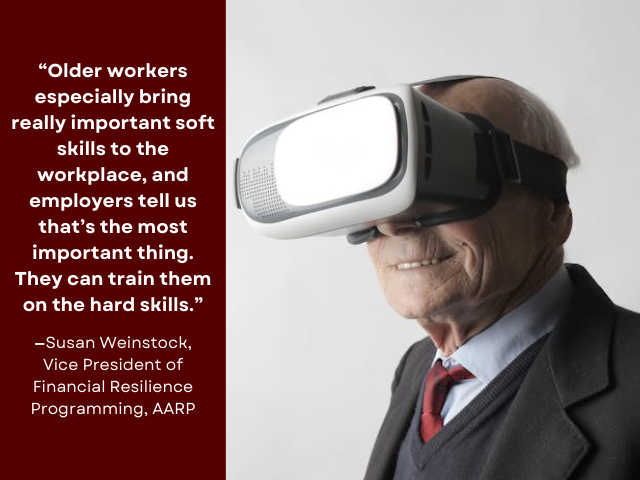
The Advantages of Training Older Workers
The reality is that training older workers is crucial for a company to stay competitive. “Companies don’t have an option. The talent gap is real and planning for it over the next decade or so will give them a true competitive advantage,” says Michele Evans, founder and CEO of NxtWaves, a membership group promoting long-term career vibrancy.
Investing in the training and development of older workers yields numerous benefits, including:
- Tapping into Experience: Older workers bring a wealth of knowledge, skills, and expertise accumulated over decades of professional experience. By providing training opportunities, corporations can harness this valuable reservoir of talent to drive innovation, problem-solving, and strategic decision-making.
- Retaining Institutional Knowledge: As older employees approach retirement, corporations risk losing critical institutional knowledge and expertise essential for business continuity. By investing in training and development, organizations can ensure the transfer of knowledge from retiring employees to younger generations, preserving valuable insights and lessons learned.
- Enhancing Diversity of Thought: Age-diverse teams bring diverse perspectives, ideas, and approaches to problem-solving, fostering creativity, innovation, and resilience. By training older workers, corporations can cultivate a culture of inclusion where all voices are valued and respected, leading to more robust decision-making and better outcomes.
- Improving Employee Engagement and Retention: Providing training opportunities signals to older workers that their contributions are important and that their careers can continue to grow and evolve within the organization. This, in turn, boosts employee morale, engagement, and retention, reducing turnover costs and strengthening the employer brand.
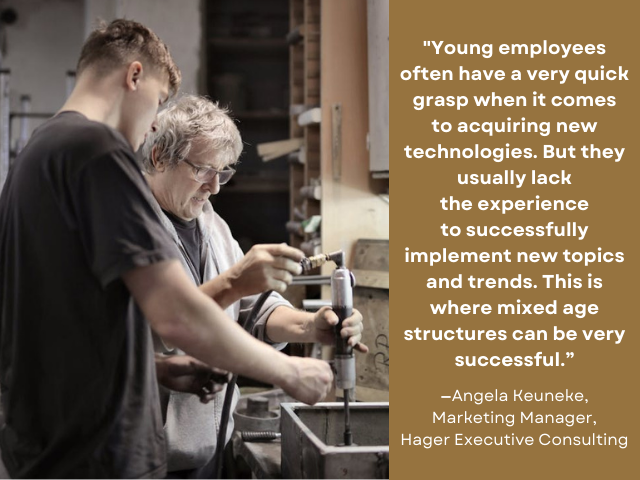
Best Approaches to Age-Inclusive Training
For best results, approach skills training not as modules for younger or older workers, but as age-inclusive. Some tips from the AARP include:
Adopt a growth mindset.
Start by intentionally working to break stereotypes about fixed abilities. Instead, create a culture of learning where everyone is encouraged to grow and learn new skills. The training itself should be varied: formal, on-the-job, group problem-solving, etc. Promote and support learning across an organization by offering training options, incentivizing managers to encourage their team to participate, and recognizing employees who try new things and develop new skills. Ensure the workplace welcomes innovative ideas, allowing individuals to feel comfortable taking risks. Instead of punishing workers for failed ideas or projects, acknowledge that sometimes failure is necessary to achieve eventual success.
Promote upskilling and reskilling for everyone.
Don’t base training and development on ageist stereotypes. For instance, don’t assume that older workers aren’t interested in learning new technology or that younger workers don’t want leadership and management training. Share information regarding training opportunities equally and simultaneously to the entire team.
Provide training in a variety of formats.
A workforce is made up of individuals who have learning preferences that determine how they best learn and retain information. Try offering a variety of learning opportunities for the same material. Some may prefer self-paced online learning, while others may favor in-person learning. Don’t forget infographics and written materials for reference.
Accept that people master skills differently.
Speed does not equal intelligence or ability, and just because someone finishes a course quickly doesn’t automatically mean their skills have improved. Some may appear to have a slower learning curve but contextualize new information through experience, improving comprehension and retention. Others may absorb information quickly and become experts at short-term tasks. The benefit is that they can all exchange information, strengthening the development of the entire team.
Use mentoring programs as a two-way exchange.
Older and younger workers can learn from each other. Older workers tend to have more experience in leadership, communication, critical thinking, and other soft skills. Younger workers who have been trained in the latest versions of technology can help their older colleagues fill in any gaps in their knowledge. A buddy system or mentoring program can be a valuable addition to structured development courses. Remember to frame mentoring as a two-way exchange.
Final Thoughts
In an era of rapid technological change and demographic shifts, organizations must embrace age diversity and invest in training older workers to remain competitive now and in the future. By breaking down barriers, fostering intergenerational collaboration, and tapping into the experience and expertise of older employees, leaders can unlock new opportunities for innovation, growth, and success. Ultimately, building an inclusive workplace where age is celebrated rather than stigmatized requires a commitment from leadership to challenge biases, promote diversity, and create a culture of lifelong learning. By prioritizing the training and advancement of older workers, businesses can create a win-win scenario where employees of all ages thrive, and the whole organization flourishes.
Resources
Clinton, Michael. “The Seismic Shift That’s About to Change the American Workplace.” Esquire. 2/13/24. Accessed 3/20/24. https://www.esquire.com/news-politics/a46754477/american-workplace-change-older-employees/
Fry, Richard and Dana Braga. “Older Workers are Growing in Number and Earning Higher Wages.” Pew Research Center. 12/14/23. Accessed 3/29/24. https://www.pewresearch.org/social-trends/2023/12/14/the-annual-earnings-of-older-workers/
Karpf, Anne. “It’s the stereotypes, not older people, that are tired.” The Guardian. 7/17/14. Accessed 4/2/24. https://www.theguardian.com/commentisfree/2014/jul/17/stereotypes-older-people-tired-cameron-new-cabinet
Kochhar, Rakesh, Kim Parker, and Ruth Igielnik. “Majority of U.S. Workers Changing Jobs Are Seeing Real Wage Gains.” Pew Research Center. 7/28/22. Accessed 4/1/24. https://www.pewresearch.org/social-trends/2022/07/28/majority-of-u-s-workers-changing-jobs-are-seeing-real-wage-gains/
Lewis, Liz. “3 Discriminatory Myths About Older Workers, Debunked.” Indeed. 5/30/19. Accessed 3/28/24. https://www.indeed.com/lead/debunk-myths-about-older-workers
McFeely, Shane and Ben Wigert. “This Fixable Problem Costs U.S. Businesses $1 Trillion.” Gallup. 3/13/19. Accessed 4/1/24. https://www.gallup.com/workplace/247391/fixable-problem-costs-businesses-trillion.aspx
“New SHRM Research Details Age Discrimination in the Workplace.” SHRM. 5/11/23. Accessed 3/20/24. https://www.shrm.org/about/press-room/new-shrm-research-details-age-discrimination-workplace
Petery, Gretchen A., James W. Grosch, and L. Casey Chosewood. “Clearing Up Myths About Older Workers While Understanding and Supporting an Aging Workforce.” CDC. 9/25/23. Accessed 3/28/24. https://blogs.cdc.gov/niosh-science-blog/2023/09/25/older-workers/
Place, Alyssa. “Older employees are adapting to remote work better than younger workers.” 1/27/21. Accessed 4/1/24. https://www.benefitnews.com/news/older-employees-are-adapting-to-remote-work-better-than-younger-workers
Powdar, Ashley. “Make It Part of Your Business to Provide Training to All.” AARP. 7/29/21. Accessed 4/2/24. https://www.aarp.org/work/employers/age-inclusive-training/
Quinby, Laura D., Gal Wettstein, and James Giles. “Are Older Workers Good for Business?” Center for Retirement Research at Boston College. 11/21/23. Accessed 3/29/24. https://crr.bc.edu/are-older-workers-good-for-business-2/
Rivers, Caryl and Rosalind C. Barnett. “Older workers can be more reliable and productive than their younger counterparts.” Vox. 10/18/16. Accessed 4/2/24. https://www.vox.com/2016/10/18/12427494/old-aging-high-tech
Schmiedek, Florian, Martin Lövdén, and Ulman Lindenberger. “Hundred Days of Cognitive Training Enhance Broad Cognitive Abilities in Adulthood: Findings from the COGITO Study.” NIH National Library of Medicine. 7/13/10. Accessed 4/2/24. https://www.ncbi.nlm.nih.gov/pmc/articles/PMC2914582/
Timmes, Michael. “The Benefits of Hiring Seniors.” Forbes. 9/25/23. Accessed 3/28/24. https://www.forbes.com/sites/forbescoachescouncil/2023/09/25/the-benefits-of-hiring-seniors
Van Vianen, Annelies E.M., Michelle Van Laethem, Constanze Leineweber, and Hugo Westerlund. “Work changes and employee age, maladaptive coping expectations, and well-being: a Swedish cohort study.” NIH National Library of Medicine. 1/7/22. Accessed 4/1/24. https://www.ncbi.nlm.nih.gov/pmc/articles/PMC9273551/
Zeljko, Natascha. “Age Diversity Is an Opportunity.” FemaleOneZero.com. 3/4/20. Accessed 4/2/24. https://femaleonezero.com/business/age-diversity-is-an-opportunity


